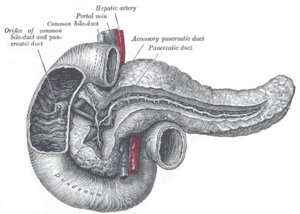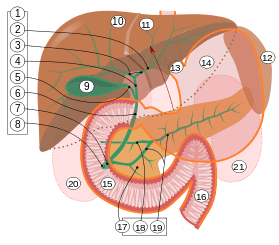Accessory pancreatic duct
| Accessory pancreatic duct | |
|---|---|
 The pancreatic duct. | |
| Details | |
| Latin | ductus pancreaticus accessorius |
| Identifiers | |
| Gray's | p.1203 |
| Dorlands /Elsevier | d_29/12314985 |
| TA | A05.9.01.017 |
| FMA | 14534 |
| Anatomical terminology | |

9. Gallbladder, 10–11. Right and left lobes of liver. 12. Spleen.
13. Esophagus. 14. Stomach. Small intestine: 15. Duodenum, 16. Jejunum
17. Pancreas: 18: Accessory pancreatic duct, 19: Pancreatic duct.
20–21: Right and left kidneys (silhouette).
The anterior border of the liver is lifted upwards (brown arrow). Gallbladder with Longitudinal section, pancreas and duodenum with frontal one. Intrahepatic ducts and stomach in transparency.
Most people have just one pancreatic duct. However, some have an additional accessory pancreatic duct also called the Duct of Santorini, which connects straight to the duodenum at the minor duodenal papilla. Both these ducts connect to the second part (the vertical segment) of the duodenum.
However, the Duct of Santorini, which bypasses the Ampulla of Vater, is non-functional whereas the Duct of Wirsung is functional and carries the digestive enzymes released by the pancreas.
In some cases, the main pancreatic duct is smaller than the accessory pancreatic duct and the two may not be connected. In such people, the accessory duct carries most of the pancreatic juice.
It is named for Giovanni Domenico Santorini.[1][2]
References
External links
- pancreas at The Anatomy Lesson by Wesley Norman (Georgetown University) (pancreasduct)
| ||||||||||||||||||||||||||||||||||||||
Template:Circulatory glands
Template:Nervous gland